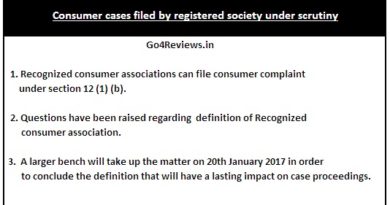Why NCDRCs judgment on section 12(1)(c) could make life difficult for consumers
We have seen the judgment from NCDRC’s larger bench on interpretation of section 12(1)(c) especially for class action where multiple buyers or association fight as a group against the respondent.
While it was touted as a beginning of movement in favor of consumers, the judgment has also left many roadblocks for consumers. Some of the key issues that are anticipated in light of the order:
- Buyers may play waiting game: Larger bench ordered that consumers or association be allowed to approach NCDRC if it represents or constitutes all consumers (buyers in case of residential projects) with common grievances and interests against the builder. In such a circumstance, there will be tendency among buyers to let some other set of buyers take the pain in proceeding to the court and would then be inclined to join that group just before the maximum limit of 2 years from cause of action or before eventual judgment.
- Delay in court proceedings: If the group approaching NCDRC doesn’t contain all consumers associated with the project, the group (or court on behalf of group) shall send private and/or public notice to other buyers as necessitated by court. The notices will be followed by a waiting period as deemed fit by court. This waiting period would typically not be less than 3 months implying delay in court proceedings.
- Builder will be made party to decision on admissibility: Larger bench has also directed that respondent party (builder) also be heard before granting permission/admitting the class action. This is expected to delay the proceedings as builder will take its own time to supply list of buyers and buyers that qualify as consumers.
- Likely to cause grudges between buyers: With larger bench directing that group approaching NCDRC shall be a representation of all consumers of the project, it would imply that buyers who are not necessarily consumers would also try to force their way into the consumer cases leading to grudges between buyers and eventually leading to delay in court proceedings.
Success rate of class action admission in NCDRC has largely declined over years. What used to be around 75%-80% in year 2011-2012 has come down to 35%-45% in 2016 with NCDRC getting increasingly conscious of the increased work such admissions will offload to it. In such a scenario, revision and a direction was on cards but it might appear that NCDRCs larger bench decision on class action has led to more questions than a widely accepted and appreciated solution. Now timely judgment will be a concern much more than just admission.
[lastupdated]




Dear go4Reviews team,
Thank you for reporting a long awaited judgement from NCDRC. The judgement is clear on many points like the value of the property to be taken in to consideration for determining the pecuniary jurisdiction, how to and arrive at the pecuniary consideration, who can join the complaint, etc. However as a lay man I am a little concerned about the effect of the judgement on a flat buyer in a large group scheme.
Let me state a likely situation :
Mr. A has bought a flat as an “under construction property” in the year 2010. The flat was contracted to be delivered in the year 2013. The total number of flats in the project was, say 2000. Many of the buyers have invested in the flat as an additional one where as Mr A has bought the property for his self-occupation. Mr. A has filed a Consumer Complaint in the year 2015 at NCDRC along with about 20 others who were similarly placed at that time requesting for early delivery of flat along with market related compensation for delay of delivery. It was filed as a joint complaint under section 12 (1) (C ). However, at the time of admission of the complaint, the Hon Bench at NCDRC had treated this complaint as a “class action suit” and ordered issue of a public notice in newspaper so that more flat buyers in the project who have a common grievance can also join the Complaint. The contents of the notice was drafted by the Hon Bench and based on the notice some 300 flat buyers in the project who have common grievance and sought similar relief had joined the complainants as impleaders.
It may be noted that the rest of the flat buyers were not interested in any legal relief as a majority of them feel that they have no guts to institute and follow up court cases.
Now, let us come to the judgement under reference. The following matters are not clear:
(a) Is it mandatory that all 2000 flat buyers should join as impleaders to make the Consumer Complaint to proceed further?
(b) Supposing some 200 buyers are NREs and are finding it difficult to file complaint, can they be left out of the purview of the judgement?
(c) You are aware that expenses for these joint Complaints are shared by all the complainants / impleaders. The judgement had stated that benefits of judgement will be available to all flat buyers. In view of this, many impleaders may decide not to continue the contribution and as a result the lead petitioners may not be in apposition to finance continuation of the proceedings. In such a situation, what will be fate of the Complaint? Can the Union Government intervene, clarify and do what is needed?
Mahalakshmi